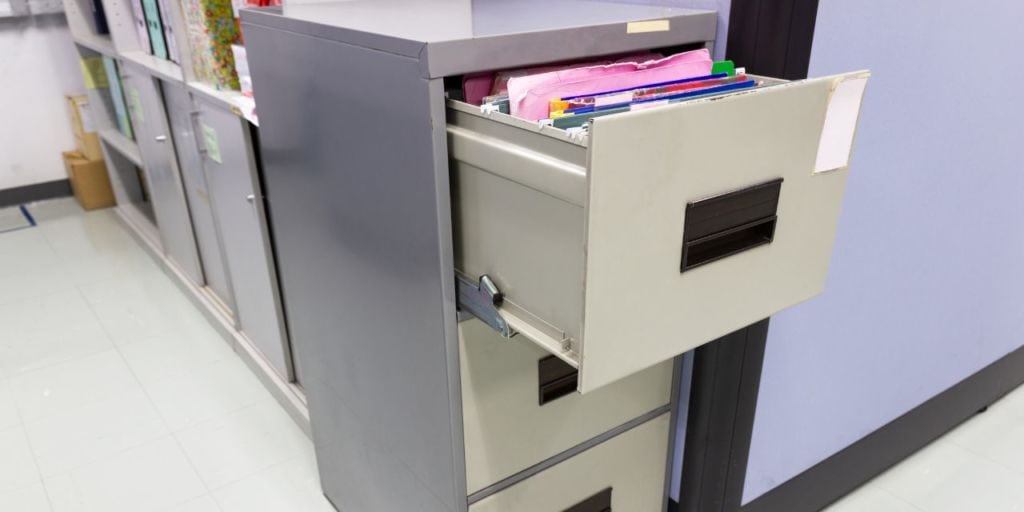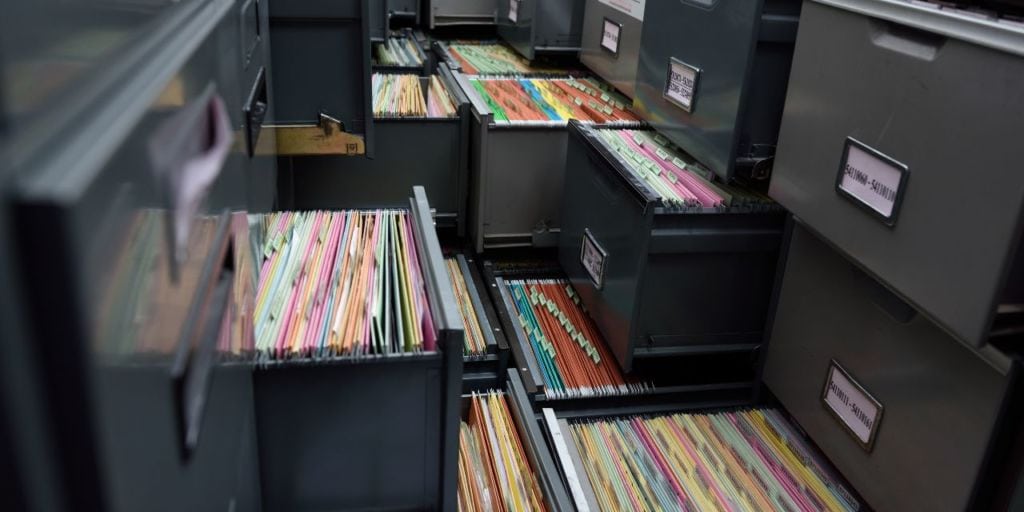Is your document storage system setting you up for potential loss or legal trouble? This guide on common mistakes in document storage and how to avoid them will help you safeguard your important documents. Discover 10 practical solutions to prevent loss, damage, and compliance failures.
Key Takeaways
- Establishing clear document retention policies helps maintain compliance, reduce clutter, and enhance document management efficiency.
- Implementing proper labeling, organization systems, and environmental controls safeguards documents from damage and ensures easy retrieval.
- Digitizing physical documents is crucial to protect against loss, theft, and disasters while improving accessibility and organization.
Mistake #1: Inadequate Document Retention Policies
Inadequate document retention policies can lead to significant compliance issues and potentially expose your business to penalties and legal troubles. An effective document retention policy should clearly specify the duration for which documents must be retained, aligning with legal and regulatory requirements. This clarity helps in managing the document lifecycle efficiently, avoiding potential legal complications.
Regularly discarding unnecessary files is crucial to prevent document clutter. It’s essential to maintain a clear distinction between current and completed work. Without a robust retention policy, businesses often find themselves overwhelmed with outdated documents, making it challenging to locate essential documents when needed. Proper document retention policies also aid in regulatory compliance, ensuring that you retain documents for the required periods and securely dispose of them when they are no longer needed.
Establishing and enforcing clear document retention policies is not just about compliance; it’s about efficient document management. By implementing these policies, you can reduce document management costs, improve document security, and ensure that sensitive business information is handled appropriately. Most document management systems provide features that help automate this process, making it easier to manage and track document retention schedules.
Mistake #2: Poor Document Organization and Filing
A common mistake in document management is poor organization and filing, which can make documents extremely difficult to find when needed. An undefined and disorganized document management workflow contributes significantly to the issue of a misplaced or lost document. Searching for paper documents in a cluttered environment can be time-consuming and frustrating, impacting overall business efficiency.
The absence of an organized system for curating and storing documents can severely affect business operations. When important records are hard to find, it disrupts workflows and reduces productivity.
Failing to establish a consistent labeling system can lead to confusion and inefficiencies. Mislabeling or using vague titles that don’t clearly indicate the document’s content can make it difficult to locate specific documents quickly. To avoid this, develop a standardized labeling convention that includes the document type, date, and relevant project or department name. This practice ensures that documents are easily identifiable and retrievable.
A structured filing system can further enhance document organization. Consider using a hierarchical filing system with primary categories, subcategories, and individual file names. This method allows for a more organized and efficient way of storing and retrieving documents.
Additionally, using a digital catalog or index that corresponds to physical files can make tracking and retrieval even more straightforward. By adopting these practices, you can significantly improve your document management and avoid the pitfalls of inadequate labeling and organization.
Mistake #3: Improper Environmental Conditions
Storing documents in areas prone to fluctuations in temperature or humidity can lead to significant damage. Basements or attics, for instance, are often unsuitable for document storage due to these environmental factors. Exposure to direct sunlight can cause documents to fade and degrade over time. Preserve document integrity by storing them in a room with stable temperature and humidity levels.
Regular inspections of storage areas are crucial to prevent damage from mold, pests, or other environmental hazards. Ideal storage conditions are around 65-70°F (18-21°C) and 45-55% humidity.
Keeping storage areas clean, dry, and away from windows or other sources of direct sunlight can further protect your documents. By maintaining proper environmental conditions, you can ensure the longevity and integrity of your stored documents.
Mistake #4: Lack of Security Measures
Leaving sensitive data in easily accessible areas increases the risk of unauthorized access or theft. To mitigate this risk, it’s essential to store sensitive documents in locked filing cabinets or safes and restrict access to authorized personnel only. Implementing access controls for employees or visitors can help prevent potential breaches.
When storing documents offsite, such as in third-party storage facilities, ensuring proper security protocols are in place is crucial. Look for facilities with robust security measures, including video surveillance, access controls, and fire protection systems. Additionally, consider implementing a sign-in/sign-out system for documents that need to be accessed regularly to maintain control over document handling.
Document security is paramount in preventing data breaches and protecting sensitive information. By adopting robust security measures and ensuring that documents are stored securely, you can significantly reduce the risk of unauthorized access and protect your organization’s valuable data.
Mistake #5: Overstuffed Storage Areas
Overloading filing cabinets or storage boxes can lead to documents being crumpled, bent, or otherwise damaged. It’s essential to use appropriately sized storage containers and ensure that documents are stored flat and not crammed together. Implementing dividers or folders can help keep documents of different sizes organized and protected.
Planning for future growth is also crucial to avoid overstuffed storage areas. Regularly assess your storage needs and expand storage space as necessary. Organized, non-overstuffed storage areas keep documents in good condition and easily accessible.
Mistake #6: Not Digitizing Physical Documents
Storing physical documents can expose your organization to several vulnerabilities, including loss, damage, and unauthorized access. Without digitization, you’re leaving your documents susceptible to information theft, fraud, espionage, and disasters like fire or flood. Converting physical documents into digital formats, such as an uploaded or scanned document, is not just a trend but a necessity for modern businesses. Implementing document scanning and digitization processes can safeguard your crucial records.
Digitizing digital documents offers multiple benefits, such as creating backups and ensuring easy recovery of important information. Imagine having all your critical documents accessible at the click of a button, regardless of where you are. It not only enhances security by limiting access to digital files but also reduces the need for physical storage, freeing up valuable office space for more productive uses.
Moreover, digitization helps in reducing physical clutter, making your workspace more organized and efficient. With most document management systems, you can easily categorize, search, and retrieve documents, reducing the chances of misplacement or loss. It’s an investment that pays off by increasing productivity and protecting your valuable information.
Mistake #7: Neglecting Regular Audits and Purges
Allowing documents to accumulate without regular review can lead to overcrowded storage and difficulty finding relevant files. Conducting regular audits to assess the relevance and necessity of stored documents is essential. Purging outdated or irrelevant documents can help declutter storage space and make it easier to locate important files.
Establishing and following a document retention policy that outlines how long each type of document should be kept is crucial. Digitizing documents where possible can reduce physical storage needs and make it easier to manage retention schedules.
By regularly auditing and purging documents, you can maintain an organized and efficient document management system.
Mistake #8: Ignoring Disaster Preparedness
Not preparing for potential disasters like fires, floods, or other emergencies can result in the loss of critical documents. Investing in fireproof and waterproof storage solutions for particularly important or irreplaceable documents is essential. Additionally, keeping duplicate copies of critical documents in a separate, secure location, possibly offsite, can provide an extra layer of protection.
Developing and regularly updating a disaster recovery plan that includes steps for protecting and recovering documents in the event of an emergency is crucial. These precautions safeguard your important documents against potential disasters.
Mistake #9: Improper Handling and Access
Frequent handling of documents without proper care can lead to wear and tear, such as creases, tears, or fading. Training staff on proper document handling techniques, such as using both hands to support documents and avoiding excessive bending or folding, can help minimize damage. Storing frequently accessed documents in protective sleeves or folders can also reduce direct handling.
Implementing a clear process for document access and handling ensures that only authorized individuals have access. By controlling document access and handling, you can protect your documents from damage and misplacement.
Mistake #10: Failing to Document the Storage Process
Not having a documented process or guidelines for storing, retrieving, and disposing of documents can lead to inconsistent practices and errors. Creating a written document storage policy that outlines best practices, storage locations, and retention schedules is essential.
Regularly training staff on the storage process and ensuring that everyone follows the established guidelines can help maintain consistency and efficiency in document management. By documenting the storage process, you can ensure that your organization follows best practices and avoids common mistakes.
Summary
In summary, effective document management is crucial for the smooth operation of any organization. By avoiding common mistakes like not digitizing physical documents, inadequate retention policies, poor organization, and lack of security measures, you can protect your valuable information and improve efficiency. Regular audits, proper handling, and disaster preparedness are also essential components of a robust document management system.
Implementing these strategies can help you create an organized and secure document management system, ensuring that your business runs smoothly and efficiently. Take the necessary steps today to improve your document management practices and safeguard your important documents.
Frequently Asked Questions
Why is it important to digitize physical documents?
Digitizing physical documents is crucial as it minimizes the risk of loss and damage while enhancing security through better access controls. Additionally, it allows for efficient storage management and easy retrieval of information.
What are the risks of not having a document retention policy?
Not having a document retention policy increases the risk of compliance violations, legal challenges, and creates inefficiencies through document clutter. It is essential to implement such a policy to safeguard your organization from these risks.
How can I improve document organization and filing?
To improve document organization and filing, implement a hierarchical filing system with folders and categories in a Document Management System, and establish a standardized labeling convention. This approach will enhance accessibility and retrieval efficiency.
What are the ideal environmental conditions for storing documents?
The ideal environmental conditions for storing documents are a temperature between 65-70°F (18-21°C) and humidity levels of 45-55%. Ensuring clean, dry storage away from direct sunlight will help preserve their integrity.
Why is disaster preparedness important for document storage?
Disaster preparedness is crucial for document storage because it prevents the loss of critical documents. By investing in fireproof and waterproof solutions and having a recovery plan, you ensure the safety of your important records.






